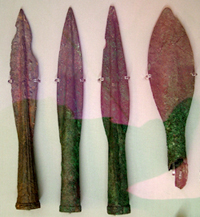 |
The Greek Age of Bronze
Spears/Javelins |
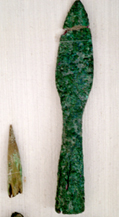 |
| The spears and the javelings are one of the most common weapons used in the Aegaen area. Copper specimens are attested since the Neolithic period in several archaeological excavations in Greece mainland and Aegean islands. During the Early and middle Bronze Age bronze spear-heads are part of the objects found in the graves of the early Greek settlements like Sesklo and Dimini.
|
| One of the earliest spear point attested in the Aegean area is this leaf-shaped copper specimen dated around 2700-2300 BC from Cycladic island of Amorgos. |
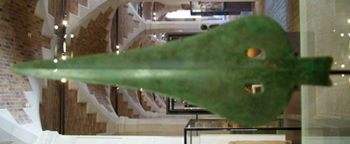 |
 |
Similar leaf-shaped spear heads both in copper and bronze are well attested in several archaeological settlements in the Cycladic islands. |
| Typical leaf-shaped Cycladic copper spear point dated around 2300 BC |
 |
 |
Another Cycladic copper spear or javelin point also dated around 2300 BC |
| Other typical pecimens of Cycladic copper and bronze spear points always dated around 2300-2000 BC |
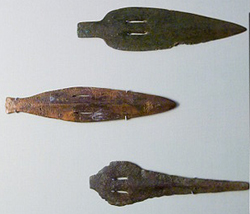 |
 |
Elongate leaf shaped spear point from Amorgos dated around 2000 BC. This specimen is 28.8 cm long.
|
| Spear points respectively from Haghia Paraskevi and Steno These blades are dated around 2300 BC. The first specimen is 15.7 cm long the second one is 18 cm long |
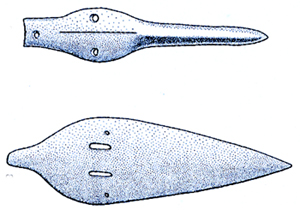 |
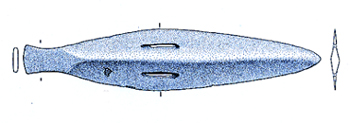 |
Spear point from Arkesine dated EH III. This specimen is 22.8 cm long |
| Another spear point from Arkesine dated around 2000 BC. This specimen is 23.2 cm long. Instead of two elongate slots this blade presents four holes used for the shaft fixation.
| 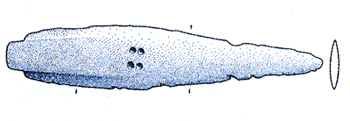 |
 |
Spear point from Mallia dated dated around 2000-1800 BC. This specimen is 28 cm long. The blade of this specimen presents longitudinal grooves and two holes for fixation. |
| Spear point from Apolodou Crete dated around 16th century BC. Also the blade of this specimen has been pierced with four holes through which a cord could be threaded in order to fix the point to the spear's wood shaft |
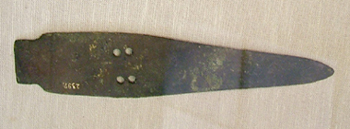 |
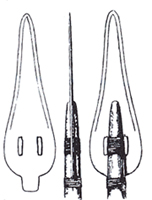 |
A pierced blade of a spear and reconstructed method of attachment.
The point blade has to be pierce with holes through which a cord could be threaded. This method was prevalent even at the beginning of the second millennium, having originated in Anatolia in the second half of the third millenium.
|
 |
Several examples of the pierced blade were found by Schliemann in Troy, like this very interesting specimen in silver dated around 2000 BC
|
| Bronze spear and javelin points dated around 2300-2000 BC from the tomb 78 of the cemetery in Vounous Cyprus. These kind of spear heads have a tang, ending in a hook, which was fixed into the wood. The blade was than further secured to the wood shaft by a wrap of laching cord. |
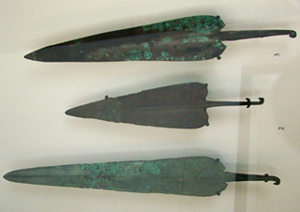 |
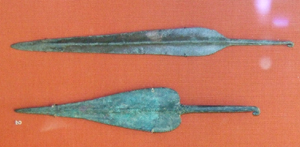 |
Other examples of copper points for spear or javelins from Cyprus dated around 2000-1900 BC |
| Other well preserved example of copper spear points fron Cyprus dated from 1900 to 1650 BC
|
 |
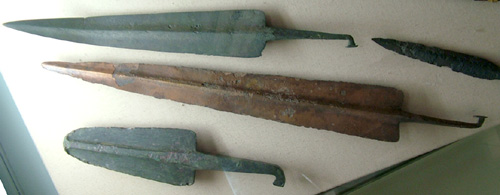 |
Various specimens of copper and bronze large spear points fron Cyprus dated from 1600 to 1200 BC
|
| The tang by which both spearheads and javelinheads, as well as javelin-butts, were attached to their shafts was ofted bent or voluted to prevent the shaft from splitting under impact. The drawing show how the fastening of such kind of spearheads were made.
|
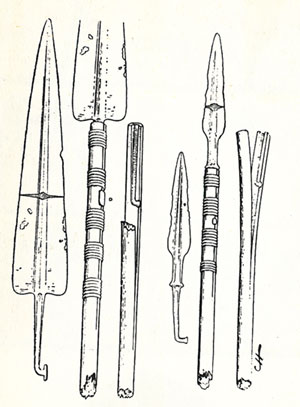 |
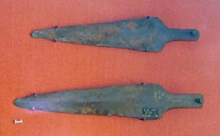 |
Other examples of copper javelin points with flat tang from Cyprus also dated around 1650 BC. |
| This Bronze double-headed blade probably dated around 16th Century BC found at Agios Onoufrios near Phaistos Crete, has been interpreted as a fish-spear. This may have been used in conjunction with a net, or on its own from an open boat.
|
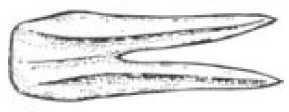 |
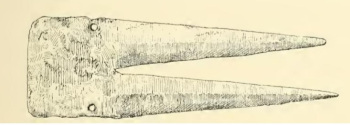 |
Another interesting bronze double-headed blade dated around 16th Century BC found at Phaistos Crete. The two holes were used to fix the blade to the wood pole.
|
| Peculiar bronze double-headed blade dated around 16th Century BC found at Agios Onoufrios near Phaistos Crete. In this case the blade has a socket on which the wood pole was inserted. A very interesting reference about this kind of double-head spear and its utilization related with the boats is also present in the Iliad during the battle inside the Achaeans camp just around the ships (*1) .
|
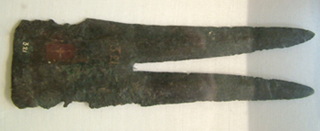 |
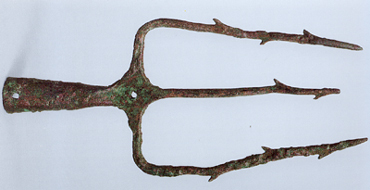 |
Even if not strictly related with spears or javelins worthy to be mentioned is this beautiful bronze trident from Haghios Nikolaos Crete dated LM IB (about 1450 BC) |
| Another very interesting trident has been found in the Achaean settlement of Hala Sultan Tekke Cyprus dated 12th Century BC. |
 |
| Spears and Javelins classification
|
The following classification of the Minoan and Achaean spear and javelin points is mainly based on the research by Hoeckmann (*2) and the further comparative analysis between the classifications of Snodgrass, Avila and Hoeckmann made by Paola Cassola Guida and Micaela Zucconi Galli Fonseca (*3). The classification has to be considered as a generic guide-line having some of the categories often closer similarity or possible design connections. For this reason the spear points assignment into a specific category is sometimes subjective. Nevertheless all the above mentioned classifications show interesting similarity for wath concern the chronological evolution of the Middle and Late Bronze Age Aegean Spear points. Also the exact distintion between Spear and Javelin points is subjective being mainly based only on the general dimension of the specimen.
The classification is divided in several main groups indicated with the letters from A to N. This generical designation corresponds to the Hoeckmann classification from A to K while the next L, M and N correspond rispectively to the A and B of the Snodgrass and M of the Hoeckmann. This last category is very dubfull, in fact these type of small points may also be identified as arrow points (see also the page dedicated to the arrows). |
| The Group A spear and javelin points have a flat or narrow fization tag, the balde is without grooves. In some specimens the blade is pierced with two elongate holes or four small holesthrough which a cord could be threaded. The points of this group are attested both in Crete than in Greece mainland. Their length is from 15.5 cm to a maximum of 38 cm. The Group A spear points are mainly dated in the MM/MH period (about 2200-1600 BC) even if some specimens are coming from later periods LM/LH III (about 1350-1200 BC). |
| Group A Bronze spear or javelin points from Crete dated MM (about 2200-1600 BC) |
 |
 |
Beautiful example of Group A spear point from Archanes Crete dated around the first half of the 17th century BC. The blade of this spear point is decorated with the head of a hybrid animal. |
| Same type of Group A spear point from Knossos also dated around 1600-1500 BC. |
 |
 |
Spear point of the Group A from Crete probably dated around 1500 BC. This specimen is 21.6 cm long |
| Another Spear point which can be included in the Group A from Thebes probably dated around 2200-2000 BC. |
 |
| The Group B spear and javelin points have the unique "shoe" shape with an hollow clutch in which the wood shaft was fixed. The Group B spear are attested both in Crete than in the Greece mainland, their general length is from 11 cm to 18.6 cm. The Group B spear and javelin points are mainly dated in the MM to LM IB (about 2200-1500 BC) in Crete and MH III to LH IA (about 1600-1550 BC) for the specimens found in the Greece mainland settlements. |
| Spear point of Group B from Steno dated around 1500 BC. This specimen is 19.2 cm long |
 |
 |
In the shaft-grave IV in Mycenae dated around 1550 BC it was also found a Group B spear point. This specimen is 18.2 cm long |
| Spear points of Group B are also attested in Albania like this specimen from Vajze dated around 1500. It is 16.5 cm long. BC |
 |
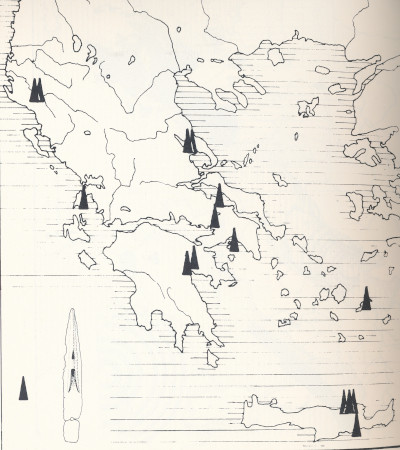 |
Distribution of the Group B spear points in the Aegean and Albania area. |
| The Group C spear and javelin points are characterize by a forged and fissured tube (*4). In the majority of these Group C points the tube is very long respect to the blade, this last is generally thin, sharp with a round section rib. The Group C spear points are very common in the Greece mainland (it is the typic spear point of the shaft graves in Mycenae). These spears have been later introduced in also in Crete and Rhodes. The general length of these points is from 14,4 cm to 60 cm. The Group C spear and javelin points are dated from MH III-LH I (about 1600-1550 BC) to LM III (about 1370-1200 BC) During the late phase the Group C points gradually lost their typic features showing several similarity with the spears and javelins of the Group D and Group G. |
 |
Group C spear point from the shaft grave II from Mycenae dated around 1600 BC. In thsi specime a ring is placed on either lower side of the tube. The rings were probably used to better secure the lance head to the shaft by means of cord. Furthermore these rings could have been also used to support some kind of plumes decoration similar to the ones attached on the spear of the battle scene represented on a gold ring from Mycenae. |
| Other big spear point of Group C from the shaft grave VI from Mycenae dated around 1550 BC
|  |
 |
Another huge Group C spear point from Mycenae always dated around 1600-1550 BC |
| The spear points of the Group C were very common in the shaft greaves from Mycenae. This is another typic specimen also dated around 1600-1550 BC. |
 |
 |
Achaean spear point of Group C from Katarraktis dated around 1500 BC. |
| Javelin point of Group C from Aghios Jannis Crete dated around 1400 BC. |
 |
 |
Achaean javelin point of Group C dated around 1350 BC. |
| The Group D spear and javelin points are also characterize by a forged and fissured tube but shorter than the one of the Group C. In some specimens the tube ended with a metallic ring and two small holes for nails or pins accomodation are present. The Group D spear points have a long blade, the rib is light and in the late specimens dated LH III has the typic "willow leaf" shape. These kind of spear and javelins points are very common in all the Aegean areas both in Greece mainland than in the islands. The general length of these points is from 14 cm to 35-40 cm. The Group D spear and javelin points are dated from the MH III-LH I (about 1600-1550 BC) to LM/LH II-III A-C (about 1500-1100 BC) |
 |
Spear points of the Group D from the grave VI in Mycenae dated around 1550 BC |
| Two examples of Group D spear points from Knossos dated around 1400 BC.
|  |
 |
Another typic Group D large spear point from Mycenae dated around 1300 BC. |
| Spear or Javelin point of the Group D from Hagia Photia Crete dated around 1400 BC. |
 |
 |
Spear point of the from Knossos Crete dated XIV century BC. |
| Another similar Group D spear point from Sanatorium Crete also dated XIV century BC.
|
 |
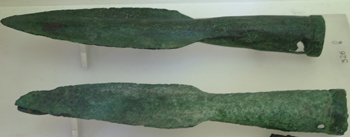 |
Two achaean spear points of the Group D dated around 1300 BC. |
| Achaean bronze spear point of the Group D from Pylos dated around 1250 BC
|
 |
 |
Bronze spear point of the Group D from Cyprus dated around 1200 BC
|
| Copper spear points of the Group D from Enkomi Cyprus dated around 1200 BC
|
 |
 |
A bronze spear or javelin point of the Group D from Crete dated XIII-XII Century BC.
|
| Bronze spear points of the Group D from the cemetery in Asine dated around 1300 BC
|
 |
 |
Spear or javelin point of the Group D from Crete dated 1100 BC.
|
| Bronze spear points of the Group D from a tholos tomb in Vafiò dated LH IIA. This specimen is 28.45 cm long and it has been found together an embossed bronze shaft.
|
 |
 |
Bronze spearhead of the Group D from Armenoi Crete dated LM IIIA-B. This specimen is 39.7 cm long
|
| Bronze spear with similarity of the Group D from Cyprus dated around 1000 BC. This specimen is 39.7 cm long
|
 |
 |
Bronze spear points of the Group D from Vafiò dated LH IIA. This specimen is 32.5 cm long.
|
| The spear and javelins points of the Group E have a long and narrow blade with a "tongue" like shape. The blade's rib is rounded and its point is blunted. The tube has a longitudinal fissure which become wider in the lower part. Both the variants with long and short tube are attested for the Group E points. Mostly of the specimens are present in Creece mainland and Crete but some examples have been also found in the East Aegean areas. The general length of these points is from 16.8 cm to 32 cm. The Group E spear and javelin points are dated from LM/LH II to LM/LH III (about 1500 to 1100 BC) |
 |
Spear point of Group E from Tanagra Crete dated around LM III (about 1300-1200 BC). |
| Another Group E spear point from Knossos dated LM III (about 1300-1200 BC).
|
 |
 |
Spear point of Group E from Thermon dated around LH IIIA. This specimen is 25.1 cm long. |
| Group E spear point from Hagios Onuphrios Crete dated about 1500 BC. This specimen is 18 cm long
|
 |
| The blade of the Group F spear and javelin points made a strong concave angle with the tube. It has an oval shape with a rectangular or flat central rib. The tube has the typic "cannon" shape with the longitudinal fissure. The Group F included several type of spear and javelin points mainly attested in Crete and in the East Aegean islands. The general length of these points is from 17.5 cm to 45 cm. The Group F spear and javelin points are dated from MM to LM/LH III B-C (about 2000 to 1100 BC) |
 |
Very beautiful spear point of Group F from Knossos dated around 1500-1450 BC
|
| Late Minoan spear point of Group F from tomb CCXVI in Haghia Fotia Crete.
|
 |
 |
Spear point of Group F from Tanagra Crete dated around LM III (about 1300-1200 BC).
|
| Late Achaean spear point of Group F from Greece Mainland dated around 1300-1200 BC.
|
 |
 |
Spear point of Group F from the tomb 44 in Kourion Cyprus dated around 1200 BC.
|
| Late Achaean spear point of Group F from Myrsinochorion dated around 1300 BC. This specimen is 45.6 cm long.
|
 |
 |
Spear point of Group F from Tegea dated around LH IIIA. This specimen is 27.15 cm long
|
| The blade of the Group G spear and javelin points made a convex angle with the tube. It has an oval shape but larger than the one of the Group F, also the central rib shows several different shape. The tube becomes shorter in the specimens from the LH III period. The Group G included several type of spear and javelin points mainly attested in Crete and in the Aegean islands, even if in minor quantity some examples dated LH III have been also found in the Greece mainland. The general length of these points is from 12.3 cm to 45.5 cm. Mostly of The Group G spear and javelin points are dated LH III A-C (about 1370-1100) but some specimens dated MM-MM III (about 2000-1600 BC) and one example dated LM/LH I (about 1550) are also attested. |
 |
Well preserved specimen of spear point of Group G from Pylos dated around 1350-1200 BC. |
| Late Minoan Javelin point of Group G from Hagia Photia Crete |
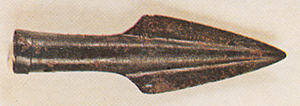 |
 |
Javelin point of Group G from Lamia dated around LH IIIB-C (about 1300-1100) |
| Spear point which can be included in the Group G from Aghia Triada Crete |
 |
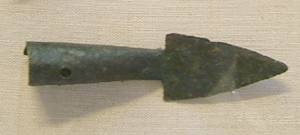 |
Iron Javelin point which can be included in the Group G from Crete dated around 1100 BC |
| Spear points of the Group G from Prosymna dated around LH IIIB. These specimen are respectively 47.05 cm and 39.1 cm long. |
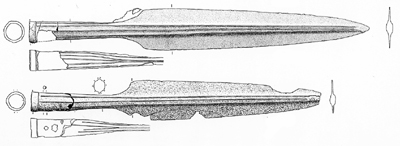 |
 |
Spear or Javelin point of the Group G from Ialysos Rhodes dated around 1300 BC. This specimen is 19 cm long |
| Javelin points of the Group G from Langada island of Kos dated around LH IIIA. This specimen is 14.4 cm long |
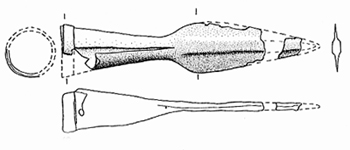 |
| The spear and javelin points of the Group H are also called "Bayonet type". These are characterized by a long and narrow blade with longitudinal grooves and central rib. The blade is a prolungation of the tube which is facets and fissured. Two holes for fixation pins and a metal ring are generally present in the lower part of the tube. The Group H points are attested in several variant coming both from Crete (Knossos palace), Greece mainland (shorter in dimension) and Rhodes island. The general length of these points is from 12.5 cm to 57 cm. Mostly of The Group H spear and javelin points are dated LM II/III A (about 1500-1370) and LH IIIA-B (about 1370-1200) even if few specimens from LH IIIC (about 1200-1100) are also attested. |
 |
Long spear point of the Group H from burial place in the bedrock under the Athenian Agora small chamber tomb under the terrace of the Middle Stoa.
The tomb was used for only one generation shortly after 1400 B.C |
| Spear point of Group H from the funerary building 3 in Archanes Crete dated around 1500-1400 BC. |
 |
 |
Spear point of the Group H with decorated blade from Archanes dated around 1500 BC. This specimen is 20.3 cm long |
| Spear point of Group H from the palace of Knossos dated around 1450 BC. This specimen is 26.5 cm long and it is characterized by a large and short cannon. |
 |
 |
Spear point of the Group H from Crete dated around 1400 BC. |
| Spear point of Group H from the palace of Knossos dated around 1400 BC. |
 |
 |
Well preserved spear points of Group H from Sanatorium Crete dated around 1400 BC. |
| Another spear point of the Group H from Knossos dated about 1400-1370 BC. |
 |
 |
Spear point of the Group H always from Knossos Crete, dated XIV century BC. |
|
| Spear point of the Group H from Greek mainland dated around 1350 BC. |
|  |
 |
Spear point of the Group H from Portes dated around 1200-1100 BC.Part of the wooden shaft is still present into the spear point. |
|
| Very beautiful spear point of the Group H with decorated blade from Dendra dated 1350 BC. This specimen is 40.6 cm long |
|  |
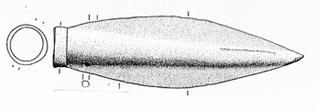 |
Short Spear or javelin point of the Group H from Mycenae dated around 1300 BC. This specimen is 16.8 cm long. |
|
| Another short spear point of the Group H from Volos dated around 1350 BC. This specimen is 20 cm long. |
| 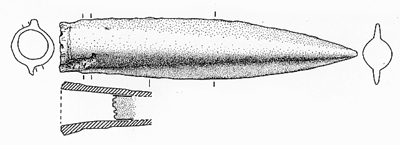 |
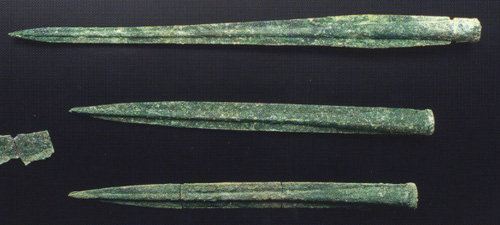 |
Very interesting and well preserved specimens of Group H spear point from the tomb 46 in Kydonia dated around 1400 BC. |
|
| During the LH IIIA (about 1370-1350 BC) together the already mentioned groups of spear and javelin points, a new type of points start to be evidenced. These show a "cannon" like tube casted in a singol element instead of forged and bended. Some scholars believe that this characteristic was imported from the central area of the Europe. During the final periods of the Late Helladic the general tendency to reduce the dimension of the blades probably attested as the light speras or javelins were more used in these periods respect to the long and heavy spears of the LM/LE II (1500-1400 BC). |
| The Group I spear and javelin points have the typic "oval leaf" shaped blade. The tube has normally the same length of the blade and it is casted (even if some specimens still have the longitudinal fissure). The spear and javelin points of the Group I are mainly attested in the Greece mainland and in less quantity in the Aegean islands. The general length of these points is from 15.5 cm to 21 cm. The Group I points are dated from TE IIIA to LH IIIB-C (about 1370-1100 BC). |
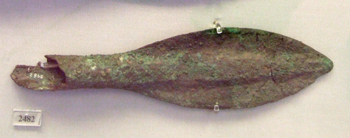 |
Achaean javelin points of Group I from Mycenae dated around 1300-1250 BC. |
| Achaean lead javelin points of Group I from Mycenae dated around XIV Century BC. The lead spear point is also attested in Mythology when Bellerophons killed the Chimeras using a spear with a lead point. |
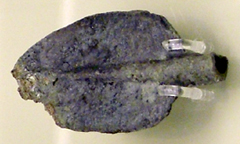 |
 |
Bronze spear point of Group I from Crete dated around 1300-1250 BC. |
| The Group K spear and javelin points have the blade in a shape of drop with a short and large casted tube. This last is also normally pierced with two holes for pins insertion. Several different type of the Group K points have been found, in mostly of these specimens a mix and manifold influence between the Aegean and balcanic areas are attested which was typic also for other weaponry during the final period of the Greek Bronze Age. The spear and javelin points of the Group K are mainly attested in the Greece mainland and the general length of these points is from 10 cm to 21 cm. The Group K points are dated LH IIIB-C (about 1370-1100 BC). |
| Beautiful example of spear point of Group K from Mycenae dated around LH IIIB. |
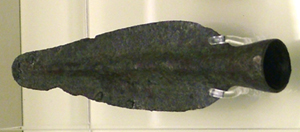 |
 |
Spear point of Group K Crete dated around XII-XII Century BC. |
| A small javelin point of Group K from Mouliana dated around XII-XII Century BC. |
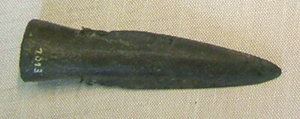 |
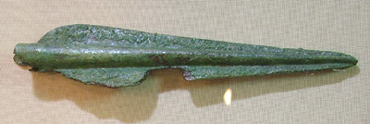 |
Spear point of Group K from Crete dated around LH IIIB-C. |
| A bronze javelin point of Group K from Zaphos Paphoura Crete dated around XIV Century BC. |
 |
 |
Spear point of Group K from Crete dated around LH IIIB-C. |
| A bronze spear point of Group K from Crete dated around 1250 BC. |
 |
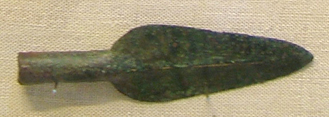 |
Spear point of Group K from Crete dated around 1100 BC. |
| A bronze javelin point of Group K from Hexalophos dated around LH IIIC. This specimen is 12.5 cm long. A fragment of the wooded shaft is still present inside this point. |
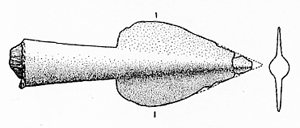 |
| The Group L spear and javelin points have the typical leaf-shaped blade and the cannon is both fissured or casted. Some specimens included in the Group L show closer similarity with the spears and javelins points of the Group D. This group include a few number of examples attested in the Greece mainland even if a single example has bee also found in Rhodes. The general length of these points is from 19.5 to 32.1 cm and are attested from the LH III B-C and during the later Submycenaean and Proto-Geometric periods. |
| Two very interesting spear points of the Group L from Kallithea dated LH IIIC (about 1200 BC)
|
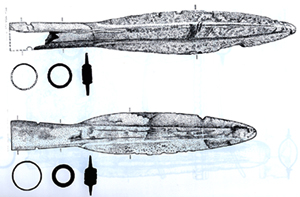 |
 |
Bronze spear points of the Group L from Mycenae dated LH IIIB
|
| Other two spear points of the Group L from Mycenae also dated LH IIIB
|
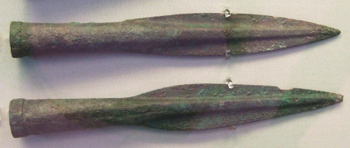 |
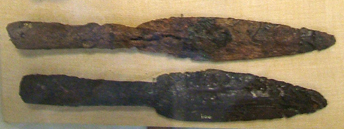 |
Iron spear points of the Group L from Crete dated about 1000 BC
|
| Two spear points of the Group L from Tragana dated around LH IIIA. These specimen are respectively 38.8 cm and 38.3 cm.
|
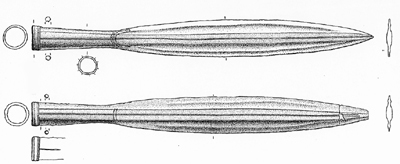 |
 |
Bronze spear points of the Group L from Tiryns dated about 1000 BC
|
| The Group M spear and javelin points have a casted cannon and a so called "lanceolate" blade with a round section central rib. These points are mainly attested in the Greece mainland even if few specimens have been also found in Crete. The general length of these points is from 9 to 29.4 cm and are dated from late LH IIIB to the LH IIIC. |
| Bronze spear point of Group M found near Thebes dated LH IIIC. This specimen is 16.2 cm long. |
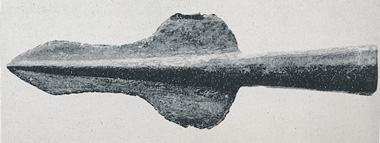 |
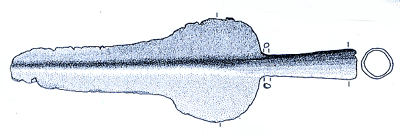 |
Bronze spear point of Group M from Gribiani dated LH IIIC. This specimen is 22.2 cm long |
| Bronze spear point of Group M from Kangadhi dated LH IIIC. This specimen is 18 cm long |
 |
 |
Bronze spear point of Group M from Konitsa dated LH IIIC. This specimen is 29 cm long |
| Bronze spear points of Group M from Aiani dated LH IIIC. These specimen are respectively 20 cm and 34.5 cm long |
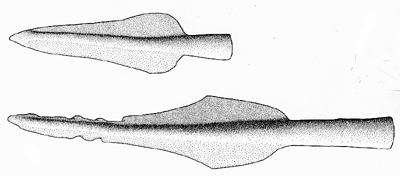 |
| The Group N include a series of small points with different dimensions, shape and design. Some have a cannon shaft some other are triangular or pyramidal with a long and thin tail, and some have a reverse V shape. The correct classification of these points it is not certain being these elements also interpreted as arrow points. These elements are well attested both in Greece mainland, Crete and Rhodes. Their general length is from 3.5 to 9.5 cm and are dated from MM II-III and LH II-III. |
| Small bronze javelin points of Group N from a chamber tomb in Isopata Crete dated around LM IIIA about 1370 BC BC. |
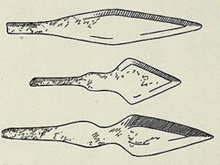 |
 |
Small javelin points of Group N (or arrow points) from Mycenae dated around 1250 BC. |
| Small javelin points of Group N (or arrow points) from Epano-Englianos, Mallia, and Mycenae dated around 1300-1200 BC. |
 |
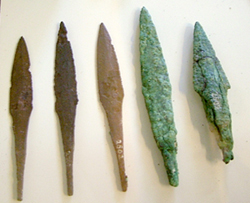 |
Small javelin points of Group N (or arrow points) from Knossos, Aghios Jannis, and Santorini Unknown datation. |
| Together the spear points have been sometimes also attested the spear butt-spikes which were the ending points of the javelins or spears. Several of these bronze points in different shape and dimensions are attested in the Aegean areas even if their presence is in minor quantity respect to the upper spear or javelin points. |
| Bronze age butt-spike of a spear or javelin from Kition Cyprus. This specimen is 14.5 cm long. |
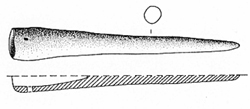 |
 |
Bronze Butt-spike of a spear from Greece mainland dated from 1350 to 1200. This specimen is exposed at the British Museum. |
| Spear or Javelin Butt-spike from Crete dated around 1300 BC. |
 |
 |
Short bronze Butt-spike of a spear or Javelin from Greece mainland dated around 1300-1200 BC. |
| Similar spear or Javelin Butt-spike from Kallithea dated around 1300-1200 BC. This specimen is 8.8 cm long |
 |
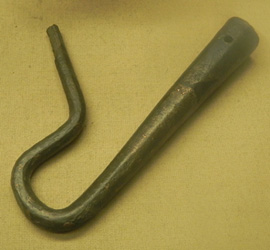 |
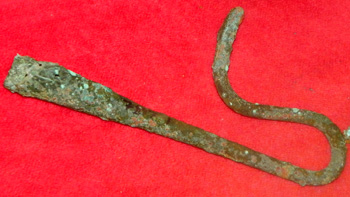 |
Several late bronze age sockets terminating in a hooked tip like the "shepherd's crook" have been found in Cyprus.Some scholars considered the shepherd's crooks as the metal version of similar wooden staffs common in pastoral communities and recalled the frequency with which Homeric leaders are described as shepherds of their folks.
The crook sceptre in Egypt is symbol of royal or divine power, and it is also shown at the hands of official visitors, perhaps because they are, or they represent, leaders |
| Even if no complete wooden shaft have survived the art representations can give a reasonable indication about the length of the spears or javelins. The first ones can be mainly divided in long spears, in some case probably more than 3 m long, and short spears.
The longer spears were used for thrusting action normally handled with both hands. The short spears could have been both used for thrusting or throwing in close combat situations or during the hunting
The javelins were normally shorter and equipped with smaller points, and were mainly used for throwing actions.
Based on the art representations the Hoeckman identify three typology of Javelins: long, short and heavy and light for long distance throwing.
|
| A unique example of short and heavy spear is attested from the Tholos tomb in Vapheio dated around LH IIA. This element is a bronze tube (survived length 78 cm) with spherical elements. This element was covering a wooden shaft being part of it still preserved inside the bronze tube. |
| Inside this bronze tube part of the wooden shaft is still preserved. The diameter of the smaller section of the tube is 2.5 cm. The larger section of the spherical elements is 2.8 cm |
 |
| This bronze shaft has been found in a tholos tomb (Vgl. Nr. 26) together a Group D spear point 28.45 cm long. Thus the survived total length of this short and heavy spear is 106.45 cm. We can supose that the real lenght of the original spear was higher, more likely around 150-160 cm |
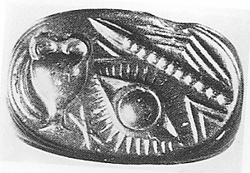 |
A similar embossed spear shaft is well represented in this seal from Mirabello Crete dated around 1600-1550 BC. This evidence attested as these kind of bronze shafts with spherical elements have probably a Minoan origin. |
| Another embossed spear shaft is also represented in this seal from Iraklion Crete dated around MM III. |
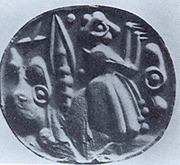 |
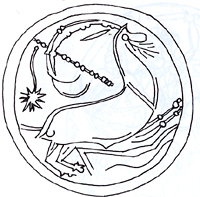 |
In this seal from Crete dated MM IIIA a goat is hit by a spear with an embossed shaft. |
| Spears with embossed shaft are also represented in these seals dated around 1500 respectively from Crete and Pylos. In this case the embossed elements are not continuous. |
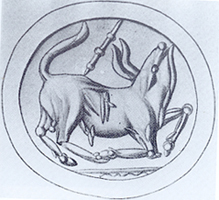 |
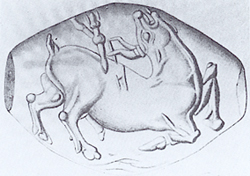 |
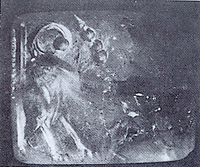 |
The use of spears with embossed shaft is also attested in a later period as shown in this Lion hunting scene engraved on a seal from Greece mainland dated around LH III. |
| A bull is hit by a spear with embossed shaft in this seal from Crete dated LH IIIA2 |
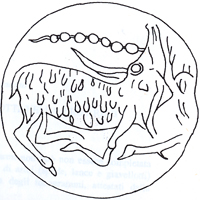 |
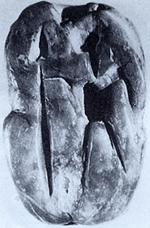 |
The earliest representation of spears or javelins in the Aegean area are dated from the EM to MM I-MM II (about 2500-1700 BC), like this images of a medium length spear of javelin with triangular point represented on a seal stone from Crete dated from 2500 to 2200 BC. |
| Some spears with triangular points are also represented in this pottery fragment from Kolonna Aigina dated MH II (about 1800-1650 BC) |
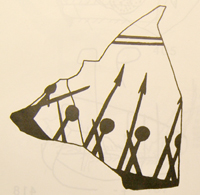 |
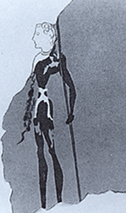 |
A joung warrior with a long spear is represented on this fresco from Knossos dated around MM III A-B |
| Very long spears are well attested in this fresco from Akrotiri in the Thera island. This fresco was clearly painted before the destruction of the Island by an earthquake followed by the volcano's eruption which based on the most recent analysis seems occurred not later of 1600 BC. In this fresco a row of warriors with long spears, swords, boar tusk helmets and rectangular body shields are depicted. Very long spears are also described in the Iliad (*5) |
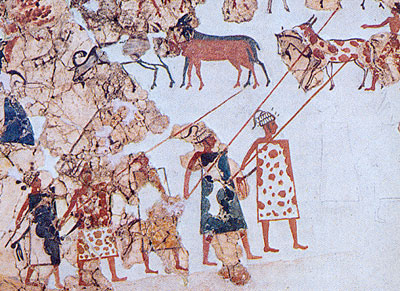 |
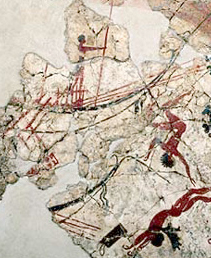 |
In the same fresco long spears are also used by some of the warriors on the ships.
A very long pike used for naval battles is described in the Iliad. It was a very strange and enormous pikes which was composed by several elements joint together with metal clinchers (*6) |
| Long spears are handled by the warriorS od deities represented in these seal stones from Knossos dated at the end of the Middle Minoan period (about 1600-1550 BC). |
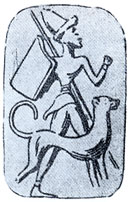 |
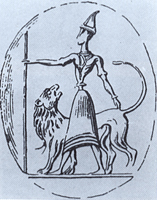 |
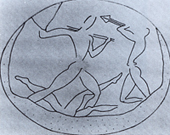 |
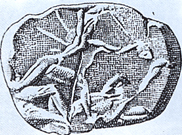 |
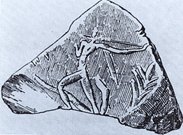 |
On some seals from Haghia Triada and Zakro dated around MM III/LM I (about 1550 BC) are attested the earliest representations of active fighting with spears |
| A fighting with a very long spear is attested in this gold ring from the shaft grave IV in Mycenae dated LH I. The shaft of this spear seem decorated with tufts. |
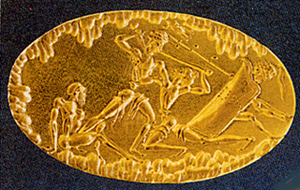 |
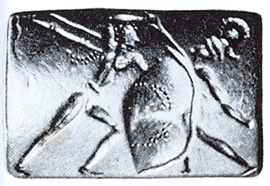 |
A very long spear is also handled by the right warrior represented in this seal from the shaft grave III in Mycenae dated LH I. |
| Fighting and hunting scene with very long thrusting spears are well represented in a silver "rhyton" and in the decorated "Lion Hunt" dagger both from the shaft-grave IV of Mycenae. In these images is clearly attested as these very long spears were normally handled with both the hands. |
| In the very rich warrior grave in Pylos dated around 1500-1420 BC a beautiful Minoan or early Achaean seal shows a warrior with a long spear.(*6a) |
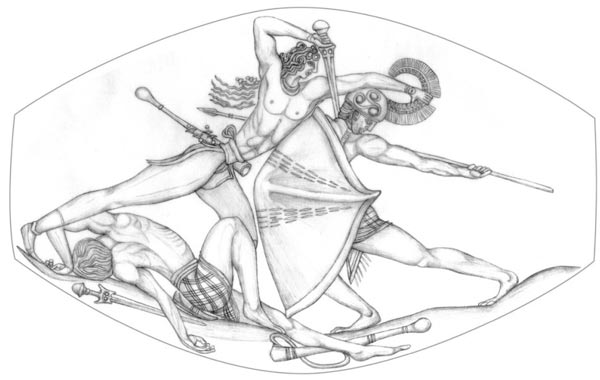 |
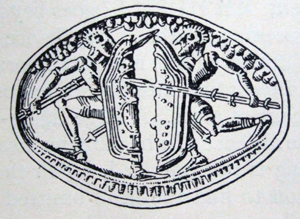 |
Two long spears are represented on a gold ring part of the controversial "treasure of seals" from Thisbe(*7).
These spears seem composed by two shafts jointed together by several rings or ribbon-like attachment and both inserted in the upper point. |
| Another spear with ribbon-like attachment is well represented in this hunting scene engraved on a seal always part of the "treasure of seals" from Thisbe |
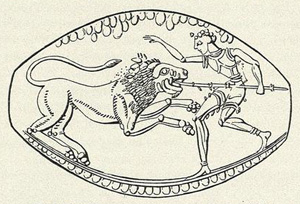 |
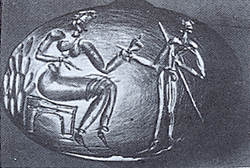 |
A short spear or javelin is represented in this cult scene on a seal from Mycenae dated around LH II. |
| An hunting scene where a short spear is used in a thrusting action against a boar is represented on this seal from Vapheio dated around LH II |
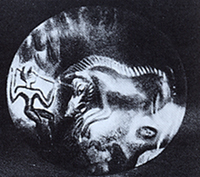 |
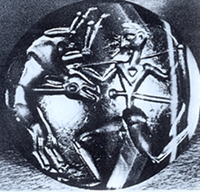 |
Similar hunting scene with a thrusting short spear used against an ibex is represented on this other seal dated LH II unknown provenace. |
| A warrior with a spear or javelin on box-chariot is engraved on this carnelian seal from Vapheio dated to the 15th century BC. The spear or the javelin were the main and the preferred weapon used from chariot by the Achaeans as attested by pictorial representations and also described in the Iliad (*8) |
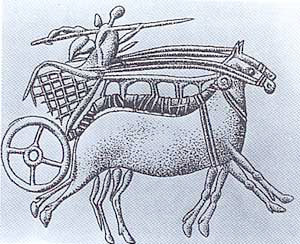 |
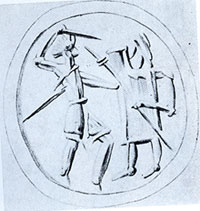 |
On a questionable seal stone from Creta dated around LM II (about 1500 BC) the warrior on the right seems to be equipped with a spear. The two small lines have been interpretaed as the elements used to fix the sperapoint into the shaft. Similar elements are in fact also represented in the spears of the Thera fresco and at least in other two pottery fragments. |
| Two warriors with spears are also represented in two jugs of Bichrome Wheelmade ware, from Cyprus dated about 1500 BC. |
| 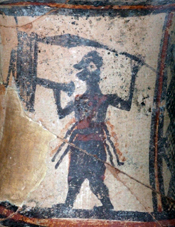 |
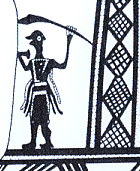 |
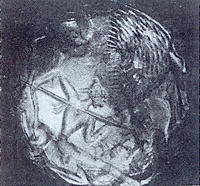 |
In this seal from Pylos dated around LH II/IIIA a warrior, who is using a thrusting spear against a boar, is well represented. During this period the shorter spears and javelins start to have much larger diffusion as also confirmed by the archaeological findings. |
| A warrior preceding a chariot is carrying on the shoulder a short spear with a leaf shaped point. This scene is represented on an Achaean krater from Ugarit SiriA dated LH IIIA2 |
| 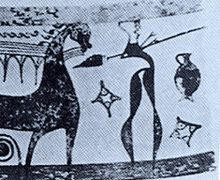 |
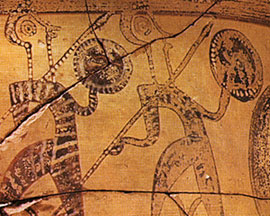 |
Two warriors with javelins and small round shield are well represented in a large krater from Tiryns dated LH IIIB2 (around 1250 BC).
|
| In a couple of krater fragments from Mycenae dated LH IIIC some warriors on chariots are equipped with spears or javelins medium size round shields which are probably beared on warrior's back by means of a baldric "Telamon". |
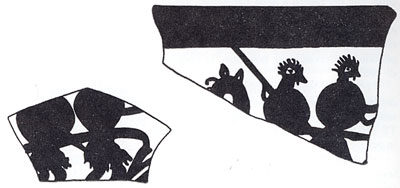 |
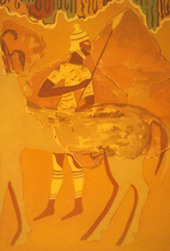 |
The javelin seems the main weapon of this warrior represented on a fresco from Mycenae dated LH IIIA/B.
|
| In these frescoes fragments from Tiryns two warriors are carrying a couple of javelins with narrow elongate points. |
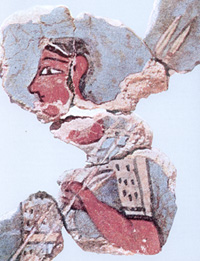 |
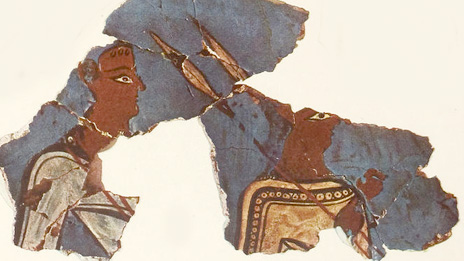 |
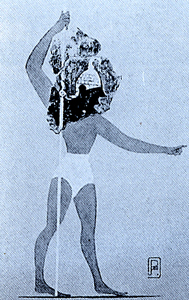 |
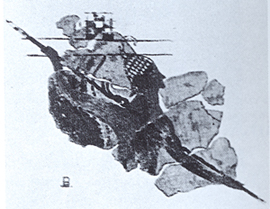 |
Long spears are represented on some fresco fragments from Pylos dated LH IIIB.
|
| Javelins are used in these fighting and hunting scenes always from frescoes in Pylos dated LH IIIB. |
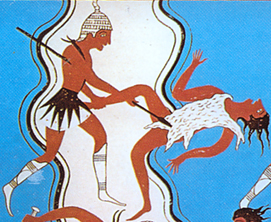 |
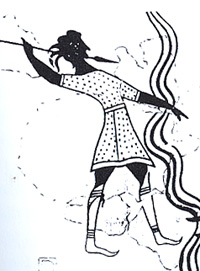 |
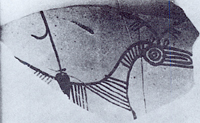 |
In this pottery fragment from Mycenae dated LH IIIB/C a deer is hit by a spear with a large leaf shaped point and a possible hook along the shaft. LH IIIB.
|
| On this seal from Naxos dated LH IIIC a warrior or a deity with a spear is represented. The spear seems to have an elengate point with blunted tip which could have similarity with some spear points of the Group D or Group E. |
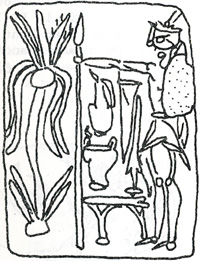 |
| On the famous warrior vase from Mycenae dated LH IIIC a group of warriors are equipped with short spears or javelins. In one of the representations of the side A the butt-spike is also visible. All the warriors represented in the side A have a small bag attached to the spears's shaft probably used as food or vine container. |
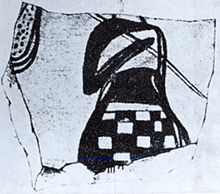 |
A bag probably with food seems to be also attached to the spear carried by this warrior represented on a pottery fragment from Mycenae dated LH IIIC
|
| Two javelins are carried by this warrior on chariot represented on a pottery fragment from Tiryns dated LH IIIC
|
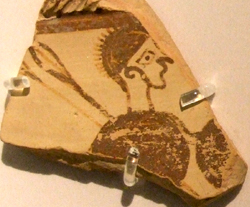 |
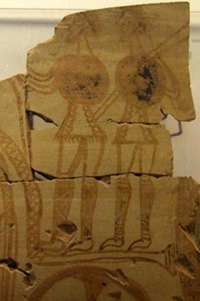 |
Two javelins are also carried by one of the two warriors on chariot represented on a pottery fragment from Tiryns dated LH IIIC
|
| A spear or javelin is carried by this hourse mounted warrior represented on a pottery fragment from Crete dated LH IIIC
|
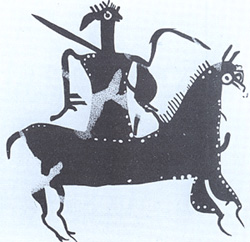 |
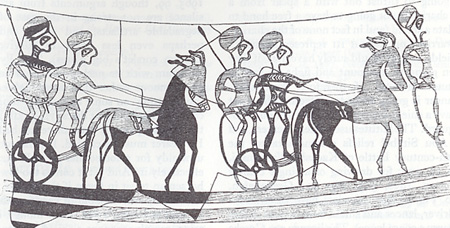 |
warriors on chariots armed with javelins or spears are well attested on some pottery fragments from Tiryns dated LH IIIC
|
| Two bronze statuettes respectively from Thermos and from the sanctuary of the Ingot God at Enkomi Cyprus dated about 1200 BC show warriors armed with spears or javelins.
|
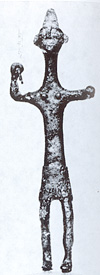 |
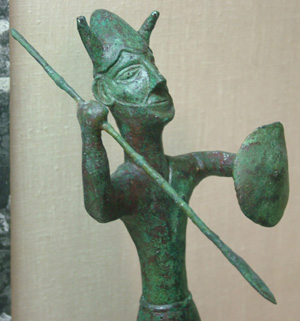 |
| SPEARS AND JAVELINS IN LINEAR B
|
| The spear are represented in the Linear B with the ideogram *230 and *254 from Knossos(*9). The first one is attested in the tablet KN 4481 where are mentioned e/ke-a ka-ka-re-a "hafts furnished with bronze spears" followed by the ideogram *230 and the number 12 which is related to the quantity. |
| The ideogram is represented with a straight line ended with a leaf shaped point with the central rib of the balde also represented. The ideogram is very stylized thus it is not possible to identify any precious type of spear point. Its interpretation as spear or javelin is also connected with the ideogram *KN 254 followed by the term pa-ta-ja. Its ideogram is composed by a simple orizzontal line ended with two converging segment which form a point. This simbol is also interpreted as an arrow even if for the arrow the very clear ideogram *KN 231 is attested. So more likely the ideogram *254 followed by the term pa-ta-ja should represent a javelin, the ideogram *230 shoud be related with the spear, and the arrow could be identify with the ideogram *231 (see also the page dedicated to the arrows). |
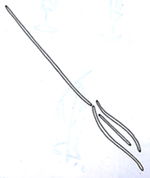
KN *230 |
| CONCLUSION
|
The spears and the javelins are one of the most common weapons used in the Aegean area since the early period of the Bronze Age.
The pictorial representations show three main variant of spears; the very long, the long one and the short one.
The first ones which could reach a length from 3 to 5 m are mainly attested in the early periods of the Late Helladic even if their utilization is still documented in the Iliad. These were used with both the hands for thrusting actions by foot soldiers against the enemy in war and against the dangerous animal during the hunting activities. More likely these kind of spears were equipped with the large bronze points of the Group C and Group H.
The long spears were used both in thrusting and throwing actions by foot soldiers or by warlord fighting from chariots. Mostly of the large and medium size spears points were used for this kind of spears which are attested during all the phases of the Late Helladic.
The short spears were also both used for throwing and for thrusting action during the close combat or hunting. In some cases the shafts of these short spears were covered with a bronze embossed tube, which gave much stability to the spear and allow a better handling. These kind of heavy short spears can also be included in the category of the heavy javelins.
The light javelins are instead mainly attested in the late periods of the Late Helladic. These were normally used for throwing both in war than during the hunting activity. The pictorial images shows that normally the warriors carried a couple of light javelins and these were the preferred weapons of the Aegean warlords fighting on chariots during the final phases of the Late Helladic. Some of the smaller points made of bronze, iron and even lead attested in the archeological findings were presumably used in the light javelins.
|
(*2)OLAF HOECKMANN; Lanze und speer im spaetminoischen und Mykenischen Griechenland 1980.
|
| (*3)PAOLA CASSOLA GUIDA, MICAELA ZUCCONI GALLI FONSECA; Nuovi studi sulle armi dei micenei. EDIZIONI ATENEO ROMA 1992.
|
| (*4)This kind of spear's tube called "cannon style" was made with a forged bronze plate bended in a cone shape in which the wood shaft was placed. This process left a longitudinal fissure normally wider in the lower part of the tube. Sometimes the fissure was almost completelly closed so and additional ring was placed in the lower part of the spear tube and tight around the wood shaft.
|
| (*5) Iliad VI, 318-320...Now Hector, dear to Zeus, strode through the gates, clutching a thrusting-lance eleven forearms long....Based on this description the Hector's spear was at least 4.8 meter long
|
| (*6) Iliad XV, 676-678...Up and down the decks of the ships he went with his great plunging strides, swinging in hand his enormous polished pike for fights at sea, clamped with clinchers, twenty-two forearms long...Based on this description this pike composed by several elements joint together with metal clinchers was almost 10 meter long
|
(*6a) Sharon R. Stocker and Jack L. Davis, The Combat Agate from the Grave of the Griffin Warrior at Pylos; Hesperia: The Journal of the American School of Classical Studies at Athens (2017).
|
| (*7) The autenticity of the seal-stones from Thisbe "treasure of seals" is actually questionable, nevertheless their iconography model are significative and more likely are based on true specimens.
|
| (*8) Iliad IV, 306-307; Iliad XI, 745-749; But the most clear evidence that in the Aegean areas the javelin and the spear were the preferred weapons to be used from the chariot is attested in the Iliad when Pandarus, disappointed about the effectiveness of his bow, decided to fight against Diomedes from the chariot using the spear instead of the bow. (Iliad V, 230-238). On the contrary in the Near East the bow was instead the preferred weapon to be used from the chariot as well attested in several pictorial images.
|
| (*9) For what concern the javelin its designation is attested in the Linear B only with the name a-ko-te-u in PY Cn 643, 2 without any ideogram
|
|